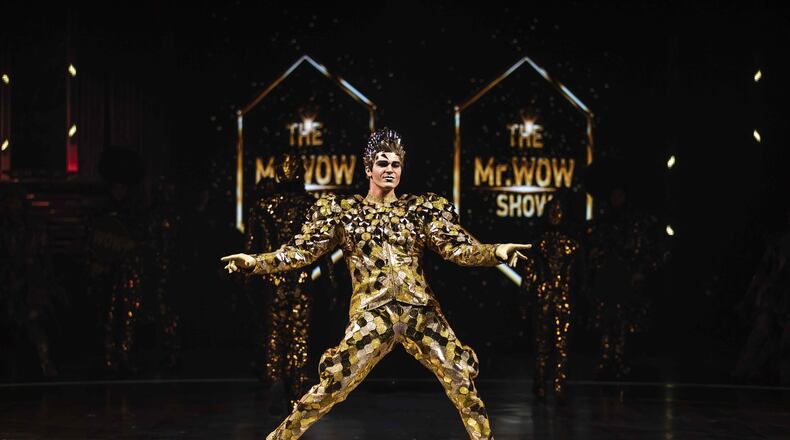The bold actions of extreme urban sports and street competitions—from bungee jumping and BMX bike riding to double Dutch rope skipping and break dancing—provide the inspiration for "Volta," Cirque du Soleil's latest big top show, coming to Atlantic Station Oct. 10.
"We're always searching for new ways of showing acrobatics and bringing different elements of amazing physical feats to the public," said artistic director Mark Shaub, who joined the touring production in July. "We wanted to explore using street sports, so we have BMX bike riders in there. We have a pas de deux between a ballet dancer and a bicycle trick rider. There's roller skating in the show."
That urban theme also carries over to the music, an integral part of every Cirque show.
“In order to capture the spirit of those street sports, we decided to go with a type of music that would match that, so we’re using an electronic music score,” said Shaub. “It’s still performed by a live band. It’s still sung by live vocalists. But it’s a different aesthetic than a lot of our other shows.”
"Volta" debuted in 2017 in Montreal, as do all Cirque shows. The storyline revolves around Waz, a young man in danger of becoming one of the Greys, a group of conforming city dwellers who are glued to their cellphones and locked into boring routines. In a bid for love and attention, Waz becomes enamored with celebrity culture and competes on the Mr. Wow Show. But things end badly when Waz is harshly judged for the thing that makes him special. Thanks to the Freespirits, escaped Greys who enjoy the freedom of being true to themselves, Waz learns to accept himself for who he is.
MORE THINGS TO DO: 7 extreme activities in and around Atlanta for adrenaline seekers
“The director of the show wanted to tell a story about accepting yourself, finding yourself and realizing who you are, and through that process setting yourself free,” said Shaub. “It’s a show that talks a lot about freedom. It talks a lot about differences (between) people.”
Ultimately, though, the narrative is a loosely framed construct to justify a bunch of cool stunts like the Trampowall, in which acrobats cavort on duel trampolines and propel themselves through windows cut into an 18-foot-high wall, or the Mirage, featuring an aerialist who hangs from her hair.
In classic circus fashion, Cirque always ends with an extravagant showstopper. In “Volta,” the finale is an elaborate BMX number.
“We have a group of five of these guys who are doing choreography with their bicycles,” said Shaub. “What’s really interesting is that in the milieu that they come from, they compete one against the other. So one of the challenges was getting these individual, competitive riders to work together as a team and create something that has momentum, that has choreography and has musical elements. They’re riding in time to the music and hitting cues. It’s really quite something to see. I’m still at the stage where my heart is up in my throat during this number.”
A former dancer, Shaub joined Cirque du Soleil in 2005 as the first artistic director of “Corteo” under the big top. Since then, he has worked on both arena and big top shows, the latter of which comes with special challenges.
“With a big top show, it’s a much bigger entity,” he said. “There are more people involved because we’re transporting our venue. We’re setting up the part that receives the patrons in the front, the concession stands, the training area for the artists, the kitchen, the offices for the staff. We’re transporting all of that and having to do our own plumbing, electricity, construction et cetera. In an arena show, we move in on a Tuesday morning, we perform on a Wednesday. We perform through Sunday. We tear down within a few hours, and we move on.”
But there are benefits to big top shows, too, he said.
“In arena shows, you’re moving more often, and you’re not in control of the venue. In a big top, we’re in control of the venue. So ‘Volta’ will look the same in Atlanta that it did when it premiered in Montreal.
“What’s also nice is we stay in the community longer with a big top,” he added. “In Atlanta, we’ll be there for three months. That gives us time to get to know the community and to have more interaction.”
The high concept storyline and all the high-tech bells and whistles aside, “Volta” is still a circus designed to appeal to all ages, said Shaub.
“Yes, it does have electronic music and street sports, but it also has a lot of classical circus in there,” he said. “We have a very talented clown that kids just adore. We have a straps act. We have many things in the show that have allowed us to reach all types of audiences. But certainly, one of the main features is that it has a very dynamic, young feel to it. We are reaching some new audiences with this.”
EVENT PREVIEW
'Volta.' Presented by Cirque du Soleil. Oct. 10-Jan. 5. $49 and up. Under the big top at Atlantic Station, 241 20th St., Atlanta. cirquedusoleil.com/volta
About the Author
Keep Reading
The Latest
Featured







